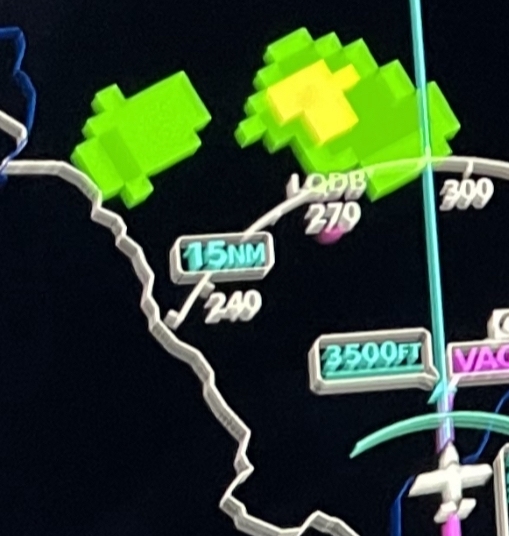Peter wrote:
Why did the engine stop?
Not sure. Co-Incidence? Really bad day at the office? I cannot get any info on why that happened. I thought they may lurk on EuroGa and could give us some insight but does not appear that way.
the B777 airframe is way “more fragile” in CB/TS than C210
Could you develop ? I would not have imagined this.
Airliners have 3D radar which essentially is software enhancement. It does its magic by saving and then merging sweeps at different tilt angles, then comparing to EWGPS terrain database which builds a perfect „wedding cake“ like image of only weather and nothing else.
Essentially it makes sure one always gets a scan picture from down low (underfly protection) on to the most reflective stuff (around freezing level) and all the way up high (for „overfly“ protection).
It takes around 40 seconds to paint a reliable picture, so frantically changing tilts or ranges is pointless. Initially 320NM to get an early view. 160NM on one ND for big picture and 80NM on the other for the slalom. 40NM to cheat one’s way onto approach when buildups are in the TMA.
A few hundred miles extra air distance due to avoiding isn’t an issue in a 500 knot plane, but there are squall lines and weather systems where that doesn’t cut it. Either you turn around (never heard of that happening) or you find a way through the labyrinth. Buckle everybody up and finish coffee in time. And, for that, big dishes (antennae) and 3D capability of airliners are really making life easier.
Older radars (I learned on non 3D radars) and especially the smaller 10“ radars are really more art than science.
Anything over 40nm range becomes difficult with a small dish.
A 10“ dish has a beam width of 8 degrees, so the beam is 10,000 feet in height (and width) at 10 NM and 100,000 feet in height (and width) at 100 NM. That’s where your ground clutter comes from. Still, there’s no alternative.
Comparison of sat datalink weather and airborne wx radar. Like @eal I 100% prefer the latter, flying in IMC means really taking chances without it.
Notice the track lines and where you’d end up following the sat weather?


I’m eager to see the new Garmin GWX8000 (3D!) in action. It could be game changer for GA radars.
@PetitCessnaVoyageur, G-limits, with C210 airframe it’s -1.5G to 3.8G while on B777 airframe are -1G to 2.5G
On V-limits, you are looking at Mach cruise of 0.84 vs VMO at 0.89 (barely 30kts at 36kft?) while on C210 it’s 150kias cruise vs VNE at 200kias (70kts at 20kft?)
CS23/CS25 certification G-limits could be misleading, you could argue that C210 may take up to 10G static without breaking while B777 up to 5G (there are documented cases on both airframes) but the two will break if speed control is lost under high G loads, however, airliners have very tight V-limits margins on their cruise altitudes
@PetitCessnaVoyageur, G-limits, with C210 airframe it’s -1.5G to 3.8G while on B777 airframe are -1G to 2.5G
The difference being that it is a lot harder to get 2.5G on a Triple7 than it is to get 3.8G on a Cessna, so in fact the 777 airframe is a lot stronger.
Of course “stronger” is relative, a wooden glider kept in control does just fine in convective weather 
I was referring to the risk of losing control or getting out of airframe or engine enveloppe, B777 has powerful engines that will outclimb their wings, in cruise it has to be flown on Rate1 turns (flies near it’s coffin corner), ideally anything else is a receipt for 20kft altitude loss or losing it’s wings
I am sure you can bank C172 80deg in cruise at FL150, I doubt you can afford that in B777 at FL360?
You can also afford to reduce power bellow 30% on engine and stall airframe or go 100% and overspeed in SEP at cruise, on do that on GE engine & B777 airframe at 36kft you are guarateed a return to 8kft with/without wings before jet engine physics & low mach aerodynamics start to make sense gain
The main advantage of an airliner (or jet fighter) for avoiding CB/TS is rather the sheer of extra speed, at 400kts you move faster than weather, where C210 in it’s green arc speeds is worthless to penetrate as you will get caught: even if WX Radar is dead right, you are not moving quickly as the “situation” around you changes quickly, imagine you saw a cell pop-out of the blue with 5min lifecycle right where you are and now you need to be 25mn away to keep your underpants dry, well that is 300kts
Surely, if you fly at 0kts your top radar in IMC or sharp eye in VMC will not helping much if you go between while it’s making popcorn !
Of course “stronger” is relative, a wooden glider kept in control does just fine in convective weather.
If fuselage / wing strength is defined by ultimate load, I am pretty sure “stronger” isn’t relative.
I am sure you can bank C172 80deg in cruise at FL150, I doubt you can afford that in B777 at FL360?
You can bank any plane in cruise 80 degrees (assuming you can overrule the bank limiter if you have one installed) as long as maintaining altitude isn’t an objective.
I am sure the latest statement is wrong, even with altitude loss either ASI or VSI has to shoot over the roof on 80deg bank unless you are happy to take +3G or lose control at some point, you can’t “unload it forever”
The B777 will be cruising “just 25kts” bellow it’s VMO, I don’t think it’s a good idea to bank it 80deg or hit 30kts windsheer, in normal operations, you are not even allowed to disengage AT/AP in cruise or cut power in calm sunny weather let alone hand fly in IMC cells, it’s very scary up there sitting on the edges even with blue sky, it’s not an F16 in cruise
BeechBaby wrote:
On a positive note the windshield held..
Re-wow!
It makes me feel glad I fly behind that same windscreen windshield (in this case that seems a more appropriate word )
On the one hand yes he should have avoided it in the first place. OTOH I must say that also airlines with experienced crews and a good Wx radar have had a large number of hail incidents this summer around the Alps regions (East France, North Italy, Bavaria..). We had to replace slats, radome, stab leading edge, and both windshields on an airliner a few weeks ago in Northern Italy…
As reminded above two key messages must be:
-Give a wide birth to strong convective activity
-Convective cycles can be quite fast…
BeechBaby wrote:
Engine quit, but they managed to belly land safely on an asphalt road in an agriculture area.
When I read it I first thought why the heck would he not extend the LG when landing on a road?
I then saw the pictures, the narrowness of the road, the fields surrounding it and the vegetation in the oil cooler inlet…obviously the right decision.
Well done to the surely very scared pilot for escaping safely in such bad circumstances.